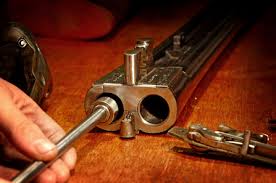Does Backboring Actually Reduce Shotgun Recoil?
Shotguns, known for their versatility, reliability and sheer power, are a favorite amongst hunters and sports shooters alike. However, using these firearms often brings with it the challenge of managing recoil, a physical force that can affect accuracy and shooter comfort. One technique purposed to address this issue is backboring, a barrel modification process. But does backboring really reduce recoil in shotguns? To understand this, we need to delve into the basics of shotgun recoil and backboring.
Understanding Shotgun Recoil: Causes and Effects
The recoil, often referred to as ‘kick’, is a fundamental aspect of shooting any firearm. Essentially, it is the reaction to the action of firing a bullet or projectile. According to Newton’s third law of motion, for every action, there’s an equal and opposite reaction. When a shot is fired, the expansion of the gunpowder generates a force that propels the shot forward and the firearm backwards. This backward motion is what we perceive as recoil.

Recoil can have several effects on the shooter. It can cause physical discomfort or even injury if not managed properly. It can also influence the shooter’s aim. The anticipation of recoil can lead to flinching, which consequently affects the shooter’s accuracy. Managing recoil, therefore, is critical for both accurate shooting and the shooter’s comfort.
Experienced shooters often employ various techniques to manage recoil, stretching from proper positioning and grip to using specific types of ammunition. One such method introduced over time is the process of backboring, a gunsmithing technique that modifies the barrel of the shotgun.
Exploring Backboring: A Brief Introduction
Backboring is a gunsmithing process that involves enlarging the bore (the interior of the barrel) of a shotgun to a diameter greater than the standard bore size. This technique is often performed to reduce recoil, improve shot patterns, and increase velocity. Backboring effectively increases the volume inside the barrel, allowing the gases created by the ignited gunpowder more room to expand.

Backboring is generally performed using a special reamer, which is inserted into the bore from the chamber end and carefully pushed through to the muzzle, enlarging the bore uniformly down its entire length. This process requires a skilled gunsmith, as uneven backboring could affect the gun’s performance, potentially making it unsafe.
Backboring is quite a popular modification, particularly among competitive shooters who appreciate the perceived benefits of reduced recoil and improved shot patterns. But what scientific explanations could support these claims? The next section explores the science behind backboring and its potential effects on shotgun recoil.
The Science Behind Backboring and Shotgun Recoil
The logic behind the backboring technique and its supposed reduction in recoil is tied to the physics of gas expansion. When a shot is fired, the ignited gunpowder creates a high-pressure gas that propels the shot forward. By enlarging the bore or the internal diameter of the barrel, backboring provides more space for these gases to expand.
This increased volume inside the barrel reduces the pressure of the expanding gases, which in turn reduces the force exerted on the shotgun – and hence, the recoil. It’s all about creating a more controlled, slower release of the gases from the barrel, which theoretically should result in a less violent recoil.
However, this explanation is a simplification of a very complex physical process. Other factors, such as the weight and design of the shotgun, the type and amount of gunpowder in the shell, and the weight and speed of the shot, can also significantly affect recoil.
Do Backboring Techniques Really Reduce Recoil?
The answer to whether backboring actually reduces recoil is not straightforward. While the science behind it is sound, the effect on recoil can be subjective and may vary based on several factors including the particular firearm, the ammunition used, and the shooter’s sensitivity to recoil.
It has been observed that some shooters do report a noticeable reduction in recoil after backboring their shotguns. However, others argue that the difference is minimal and could even be a placebo effect. Some believe that the change in recoil can be more attributed to the weight increase of the shotgun due to the added material during the backboring process, rather than the increased bore size itself.
Indeed, the science of firearms is complex, and the real-world application of techniques like backboring can lead to varied results. While backboring has its proponents and critics, what is clear is that each shooter needs to find what works best for their personal comfort and shooting style.
In conclusion, while the science suggests that backboring, through creating more space for the gases to expand, could potentially reduce the recoil of a shotgun, the real-world results seem to vary greatly. It’s important to remember that managing recoil is not just about barrel modifications. Proper technique, firearm selection, and ammunition choice are all crucial elements to consider. As always, it’s recommended to seek professional advice when considering modifications like backboring, and above all, prioritize safety at all times while handling firearms.
# # #


Comments